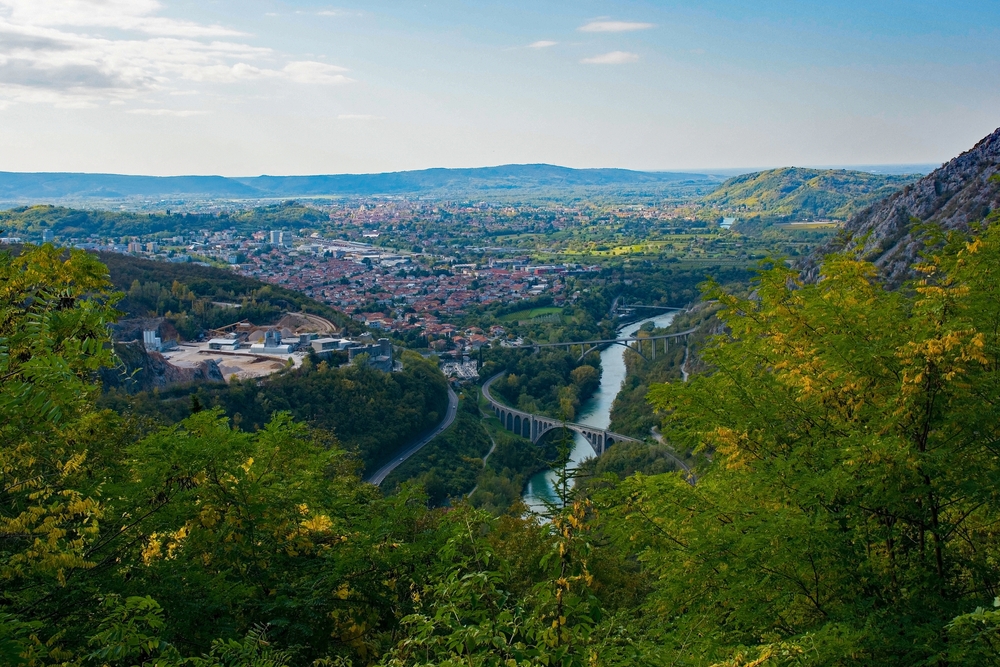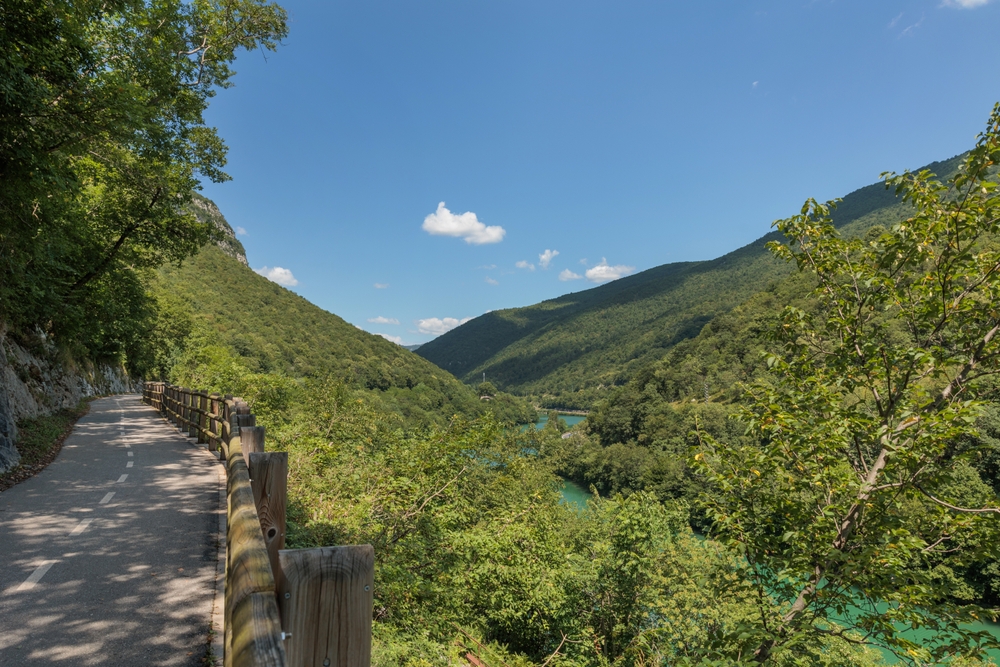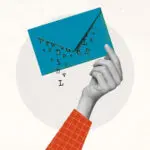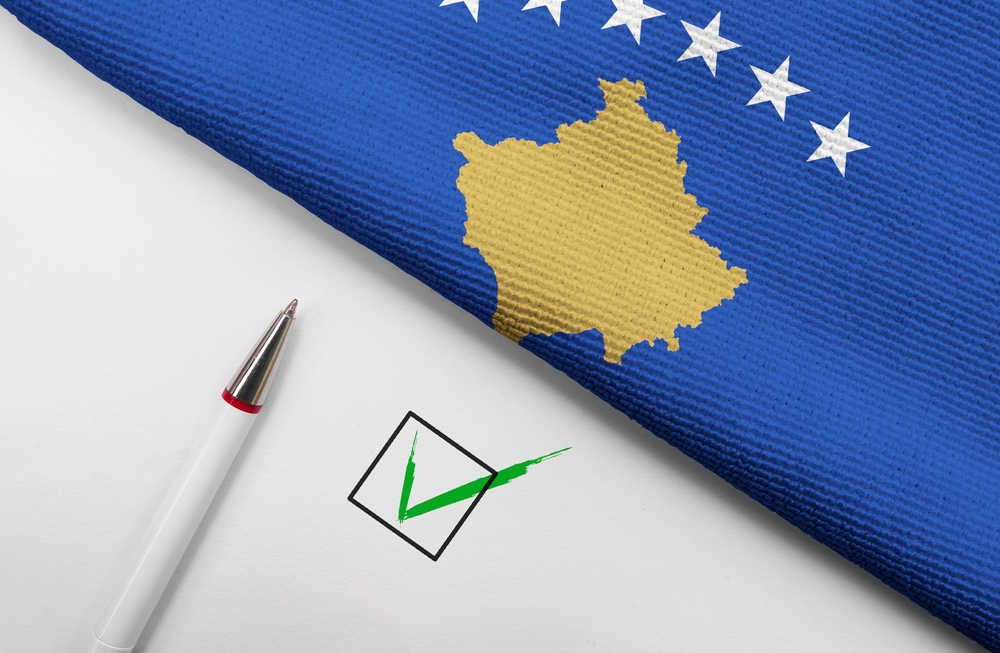Cycling between environment and memory: the new Isonzo-Soča cross-border park
The warm season will be an opportunity to test the new infrastructures and strategies of an EU-funded project in the municipalities of Gorizia, Nova Gorica, and Šempeter-Vrtojba, a border area that conceives itself as a single, homogeneous territory along the river Soča
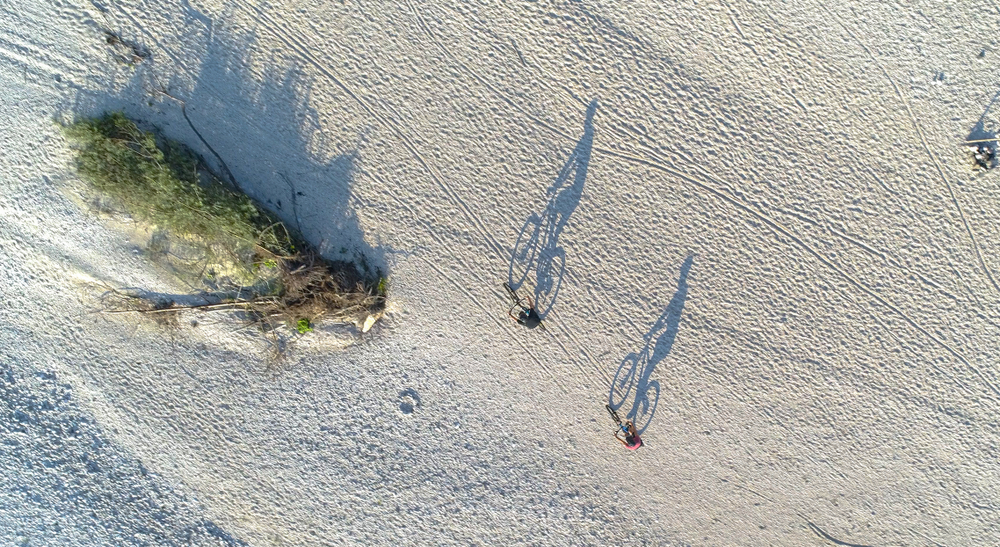
Cycling-between-environment-and-memory-the-new-Isonzo-Soca-cross-border-park
Cycling along the Soča - ©Flystock/Shutterstock
The most prestigious and symbolic seal was placed by the two presidents, Italian Mattarella and Slovenian Pahor, who in October 2021 inaugurated the footbridge over the Soča in Salcano. The occasion, which coincided with the celebrations for the nomination of Gorizia-Nova Gorica as European Capital of Culture 2025, confirmed how that crossing of the border, that connection between the two shores, was the ideal but also concrete representation of the ambitions and projects, of the results and conquests, of a territory that rather than "borderline" likes to call itself "cross-border". The walkway – as confirmed by Tanja Curto of the EGTC, the European group of territorial cooperation who created it – was an achievement in many respects, not least the bureaucratic one: EU funds from the Italy-Slovenia Interreg , design by the body based in Italy, application of the Slovenian procurement code, a Babel that unraveled without a hitch. And that bridge is just a piece of the wider project of the Isonzo-Soča park, managed by the EGTC, which with a network of cycle-pedestrian paths, equipped areas, parking lots, and new itineraries contributes to the usability of the border area as well as to the habitability of the cross-border territory and its promotion.
The care of the border, between preservation and maintenance
Drawn as a line on maps, conceived as a clean cleavage in the mind, the border also has a width, a thickness, a density, as is well known by those who cross it and experience it every day, in Gorizia-Nova Gorica but not only. And yet, despite the collapse of the Iron Curtain, despite Slovenia’s entry into the EU and subsequently into the Eurozone, the Italian-Yugoslav bilateral body created in 1980 as the Joint Italian-Slovenian Commission for the maintenance of the State Border survived: reconfirmed in 1992 with the succession of Slovenia in the bilateral treaties, the commission was renewed in 2007 with an agreement between the two governments; and it is no coincidence that the Foreign Minister was Franco Frattini, who would soon become president of the EGTC.
Decades go by, the nature of the borders changes, and the borders also change management and maintenance, but it is always the same commission that gives the go-ahead, when things are done, including the footbridge over the Soča. "The development of cross-border initiatives – reads a statement referring to a meeting of the commission in December 2021 – is a further step forward in the increasingly deep-rooted relationship of collaboration, cooperation, and friendship between the Italian and Slovenian administrations and communities".
Beyond the "maintenance" carried out by this bilateral organisation, which worked for a few years on the catalogue of border coordinates and descriptions (8 volumes) and on the atlas of border maps and charts (88 orthophoto maps), the path of the historic frontier between the two blocks has offered opportunities for tourist-cultural development elsewhere too, from the Baltic to the Bosphorus.
The border strip between the two German Republics, for example, measures up to 200 metres in width – a strip of land that remained intact during the 40 years of survival of the German Democratic Republic, so much so that it hosted over 5,200 animal and plant species, of which at least 1,000 at risk of extinction. Hence the interest of some German biologists, who had already begun to study that strip in the 1980s and who, after the reunification, worked to keep it intact. The idea then extended along the over 12,000 kilometres of curtain wall, and the “European Green Belt ” was born, in defense of what is defined as "an extraordinary ecological fabric, a vivid landscape of memory". From the Barents Sea along the Baltic coasts through Central Europe and the Balkans to the Black Sea and the Adriatic, the border area, reads the presentation, “gave nature a break, thus creating a living area”.
Preserve and promote, the vision
The ambitious goal of the European Green Belt initiative, namely "to harmonise human activities with the natural environment, increasing opportunities for socio-economic development for local communities", echoes the intentions of the EGTC experts in their study of the cross-border area along the Soča. In fact, that stretch of the river on which the design was concentrated is a fragment of the European green oasis, having marked the border between the two blocks for decades.
The driving force behind the project for the Isonzo-Soča cross-border park, the construction of which officially ended last November, was in fact the intention to "promote and increase the usability, also by residents, of the cross-border territory crossed by the Soča river in the Municipalities of Gorizia, Nova Gorica, and Šempeter-Vrtojba, preserving and enhancing their natural and cultural heritage".
Specifically, the area now has a new network of cycling and walking paths, a parking space for campers and the Soča footbridge as well as a recreation area in Vrtojba- Camp Vrtojba. These infrastructures are located on both sides of the border, but designed and built with delegation from the EGTC, applying from time to time the Slovenian or Italian legislation on procurement law. The municipal councils of the three municipalities of Gorizia, Nova Gorica, and Šempeter-Vrtojba have thus laid the foundations for a unitary methodology for planning the territory of the three cities, albeit in two different national states.
The project starts from meticulous and widespread consultations involving politicians, hoteliers, associations, and academics on both sides of the border, and is based on an integrated study of the cross-border area inspired by the "urban agendas" of all three municipalities. A synthesis which, as pointed out by Tomaž Konrad, deputy director of the EGTC, manages to multiply the positive effects for all subjects. In fact, by comparing and summarising the different agendas, the strategic plan has grasped a common vision, from the impetus to the economy by focusing on food and wine tourism to the development of the attractiveness of historic centres, from the promotion of the use of bicycles to the pursuit of a vital and dynamic and planned urban development, with the promotion of "slow travel" and the organisation of major cross-border events.
From Venice to Klagenfurt, via Ljubljana
The analyses that accompanied the EGTC study did not fail to highlight the differences between the Slovenian and Italian municipalities. With a GDP for Gorizia 8% lower than the Friuli regional average and for Nova Gorica and Šempeter-Vrtojba 9% lower than the Slovenian national average, the territory shares the same condition of "medium development area", with similar unemployment rates; on the other hand, the wage differences are marked, with 28,000 Euros per year on the Italian side against 18,500 in Slovenia.
Attention to economic data has thus turned into concrete proposals relating to human resources, as the promotion of the cross-border park and its future usability depend on the people that the system will be able to involve. The analyses show the need for linguistic training on both sides, with the suggestion to "swap" manpower. "The workers on the Italian side have greater knowledge and practical skills, while the Slovenian ones have more conceptual knowledge and linguistic skills, therefore it would be sensible to provide for an exchange of manpower”. People should then be adequately trained in the field of tourism entrepreneurship, so that the economic fabric can adapt to the changing market conditions.
The macroscale that places the cross-border park in a territorial context "between Venice and Klagenfurt, passing through Ljubljana", describes and analyses its tourist potential by listing at least five areas of attraction along the three landscapes of the Soča, from its source to its mouth via the border area: sports activities related to the river (rafting, kayaking, canyoning); the integration of cycle paths with public transport; the places of the Great War with the paths of peace, the cemeteries, the ruins; cultural and entertainment events such as festivals, concerts, fairs; and seaside tourism in the Grado area. All to attract a visitor attentive to the food and wine offers.
Attracting the curious traveller
The new cycle ring starts from the Solkan bridge, crosses some agricultural areas passing through the historic centre of Gorizia and Šempeter (the city of violets), along the Panovec forest and Nova Gorica, ends at the Soča Fun Park in Salcano, and touches the main interchange points with railways, buses, and car parks. It is about fifty kilometres, over half of which have been built from scratch: a dozen retrace the border line towards the Carso, with Transalpina Square and a series of mini-museums, connecting to the Slovenian national Salcano-Piave cycle path, while passing for about thirty kilometres along the river through the fields of via degli Scogli, the Torrione bridge, and the hydroelectric plant of Straccis.
"The development of cross-border tourism is a complex undertaking", admit the EGTC planners in the final report, which nonetheless suggests concrete ideas for starting the operation. First of all, it is necessary to develop a clear, recognisable identity for the area which will have to be able to offer "unique cross-border cultural and food and wine experiences to tourists looking for recreation halfway between city and nature", the so-called "experience tourists". And the appeal will be able to draw on a basin rich in 35 million tourist presences at the macro-regional level (Venice and Grado included), with almost two million presences attributable to gambling tourism in Nova Gorica.
The target includes, therefore, those who are called "the explorers" in the document, i.e. tourists interested not only in Venice but also in the liveliness of the capital Ljubjana, in the casinos but also in bike rides from the Upper Soča valley to the sands of Grade. And to do this, the visibility of the area will need to be strengthened as a diverse unicum, a place of departure and connection between culture, food and wine, and landscape, focusing on a single, shared "cross-border brand", also thanks to new events to be agreed between the three municipalities.
There are still many things to do, also because "promotion comes after product development and not vice versa": a competition of ideas is suggested to define the identity and tourist brand of the area as "cultural and culinary heart of Europe”, as well as a plan to promote the places of the Great War, developing signage, digitizing the guides. It is recommended to improve the infopoint of the Salcano bridge but also of Transalpina Square, a "totally under-developed" tourist attraction, and in general to develop a joint offer of souvenirs, under the banner of a common brand, involving private actors.
The expectations are there, the good premises too. And above all, as the EGTC designers confirmed to us, there are many unexpressed energies waiting to be fostered and coordinated, now ready for the summer test.
This content is published in the context of the “Work4Future” project co-financed by the European Union (EU). The EU is in no way responsible for the information or views expressed within the framework of the project. The responsibility for the contents lies solely with OBC Transeuropa. Go to the “Work4Future“
Tag: Work for Future
Featured articles
- Take part in the survey
Cycling between environment and memory: the new Isonzo-Soča cross-border park
The warm season will be an opportunity to test the new infrastructures and strategies of an EU-funded project in the municipalities of Gorizia, Nova Gorica, and Šempeter-Vrtojba, a border area that conceives itself as a single, homogeneous territory along the river Soča

Cycling-between-environment-and-memory-the-new-Isonzo-Soca-cross-border-park
Cycling along the Soča - ©Flystock/Shutterstock
The most prestigious and symbolic seal was placed by the two presidents, Italian Mattarella and Slovenian Pahor, who in October 2021 inaugurated the footbridge over the Soča in Salcano. The occasion, which coincided with the celebrations for the nomination of Gorizia-Nova Gorica as European Capital of Culture 2025, confirmed how that crossing of the border, that connection between the two shores, was the ideal but also concrete representation of the ambitions and projects, of the results and conquests, of a territory that rather than "borderline" likes to call itself "cross-border". The walkway – as confirmed by Tanja Curto of the EGTC, the European group of territorial cooperation who created it – was an achievement in many respects, not least the bureaucratic one: EU funds from the Italy-Slovenia Interreg , design by the body based in Italy, application of the Slovenian procurement code, a Babel that unraveled without a hitch. And that bridge is just a piece of the wider project of the Isonzo-Soča park, managed by the EGTC, which with a network of cycle-pedestrian paths, equipped areas, parking lots, and new itineraries contributes to the usability of the border area as well as to the habitability of the cross-border territory and its promotion.
The care of the border, between preservation and maintenance
Drawn as a line on maps, conceived as a clean cleavage in the mind, the border also has a width, a thickness, a density, as is well known by those who cross it and experience it every day, in Gorizia-Nova Gorica but not only. And yet, despite the collapse of the Iron Curtain, despite Slovenia’s entry into the EU and subsequently into the Eurozone, the Italian-Yugoslav bilateral body created in 1980 as the Joint Italian-Slovenian Commission for the maintenance of the State Border survived: reconfirmed in 1992 with the succession of Slovenia in the bilateral treaties, the commission was renewed in 2007 with an agreement between the two governments; and it is no coincidence that the Foreign Minister was Franco Frattini, who would soon become president of the EGTC.
Decades go by, the nature of the borders changes, and the borders also change management and maintenance, but it is always the same commission that gives the go-ahead, when things are done, including the footbridge over the Soča. "The development of cross-border initiatives – reads a statement referring to a meeting of the commission in December 2021 – is a further step forward in the increasingly deep-rooted relationship of collaboration, cooperation, and friendship between the Italian and Slovenian administrations and communities".
Beyond the "maintenance" carried out by this bilateral organisation, which worked for a few years on the catalogue of border coordinates and descriptions (8 volumes) and on the atlas of border maps and charts (88 orthophoto maps), the path of the historic frontier between the two blocks has offered opportunities for tourist-cultural development elsewhere too, from the Baltic to the Bosphorus.
The border strip between the two German Republics, for example, measures up to 200 metres in width – a strip of land that remained intact during the 40 years of survival of the German Democratic Republic, so much so that it hosted over 5,200 animal and plant species, of which at least 1,000 at risk of extinction. Hence the interest of some German biologists, who had already begun to study that strip in the 1980s and who, after the reunification, worked to keep it intact. The idea then extended along the over 12,000 kilometres of curtain wall, and the “European Green Belt ” was born, in defense of what is defined as "an extraordinary ecological fabric, a vivid landscape of memory". From the Barents Sea along the Baltic coasts through Central Europe and the Balkans to the Black Sea and the Adriatic, the border area, reads the presentation, “gave nature a break, thus creating a living area”.
Preserve and promote, the vision
The ambitious goal of the European Green Belt initiative, namely "to harmonise human activities with the natural environment, increasing opportunities for socio-economic development for local communities", echoes the intentions of the EGTC experts in their study of the cross-border area along the Soča. In fact, that stretch of the river on which the design was concentrated is a fragment of the European green oasis, having marked the border between the two blocks for decades.
The driving force behind the project for the Isonzo-Soča cross-border park, the construction of which officially ended last November, was in fact the intention to "promote and increase the usability, also by residents, of the cross-border territory crossed by the Soča river in the Municipalities of Gorizia, Nova Gorica, and Šempeter-Vrtojba, preserving and enhancing their natural and cultural heritage".
Specifically, the area now has a new network of cycling and walking paths, a parking space for campers and the Soča footbridge as well as a recreation area in Vrtojba- Camp Vrtojba. These infrastructures are located on both sides of the border, but designed and built with delegation from the EGTC, applying from time to time the Slovenian or Italian legislation on procurement law. The municipal councils of the three municipalities of Gorizia, Nova Gorica, and Šempeter-Vrtojba have thus laid the foundations for a unitary methodology for planning the territory of the three cities, albeit in two different national states.
The project starts from meticulous and widespread consultations involving politicians, hoteliers, associations, and academics on both sides of the border, and is based on an integrated study of the cross-border area inspired by the "urban agendas" of all three municipalities. A synthesis which, as pointed out by Tomaž Konrad, deputy director of the EGTC, manages to multiply the positive effects for all subjects. In fact, by comparing and summarising the different agendas, the strategic plan has grasped a common vision, from the impetus to the economy by focusing on food and wine tourism to the development of the attractiveness of historic centres, from the promotion of the use of bicycles to the pursuit of a vital and dynamic and planned urban development, with the promotion of "slow travel" and the organisation of major cross-border events.
From Venice to Klagenfurt, via Ljubljana
The analyses that accompanied the EGTC study did not fail to highlight the differences between the Slovenian and Italian municipalities. With a GDP for Gorizia 8% lower than the Friuli regional average and for Nova Gorica and Šempeter-Vrtojba 9% lower than the Slovenian national average, the territory shares the same condition of "medium development area", with similar unemployment rates; on the other hand, the wage differences are marked, with 28,000 Euros per year on the Italian side against 18,500 in Slovenia.
Attention to economic data has thus turned into concrete proposals relating to human resources, as the promotion of the cross-border park and its future usability depend on the people that the system will be able to involve. The analyses show the need for linguistic training on both sides, with the suggestion to "swap" manpower. "The workers on the Italian side have greater knowledge and practical skills, while the Slovenian ones have more conceptual knowledge and linguistic skills, therefore it would be sensible to provide for an exchange of manpower”. People should then be adequately trained in the field of tourism entrepreneurship, so that the economic fabric can adapt to the changing market conditions.
The macroscale that places the cross-border park in a territorial context "between Venice and Klagenfurt, passing through Ljubljana", describes and analyses its tourist potential by listing at least five areas of attraction along the three landscapes of the Soča, from its source to its mouth via the border area: sports activities related to the river (rafting, kayaking, canyoning); the integration of cycle paths with public transport; the places of the Great War with the paths of peace, the cemeteries, the ruins; cultural and entertainment events such as festivals, concerts, fairs; and seaside tourism in the Grado area. All to attract a visitor attentive to the food and wine offers.
Attracting the curious traveller
The new cycle ring starts from the Solkan bridge, crosses some agricultural areas passing through the historic centre of Gorizia and Šempeter (the city of violets), along the Panovec forest and Nova Gorica, ends at the Soča Fun Park in Salcano, and touches the main interchange points with railways, buses, and car parks. It is about fifty kilometres, over half of which have been built from scratch: a dozen retrace the border line towards the Carso, with Transalpina Square and a series of mini-museums, connecting to the Slovenian national Salcano-Piave cycle path, while passing for about thirty kilometres along the river through the fields of via degli Scogli, the Torrione bridge, and the hydroelectric plant of Straccis.
"The development of cross-border tourism is a complex undertaking", admit the EGTC planners in the final report, which nonetheless suggests concrete ideas for starting the operation. First of all, it is necessary to develop a clear, recognisable identity for the area which will have to be able to offer "unique cross-border cultural and food and wine experiences to tourists looking for recreation halfway between city and nature", the so-called "experience tourists". And the appeal will be able to draw on a basin rich in 35 million tourist presences at the macro-regional level (Venice and Grado included), with almost two million presences attributable to gambling tourism in Nova Gorica.
The target includes, therefore, those who are called "the explorers" in the document, i.e. tourists interested not only in Venice but also in the liveliness of the capital Ljubjana, in the casinos but also in bike rides from the Upper Soča valley to the sands of Grade. And to do this, the visibility of the area will need to be strengthened as a diverse unicum, a place of departure and connection between culture, food and wine, and landscape, focusing on a single, shared "cross-border brand", also thanks to new events to be agreed between the three municipalities.
There are still many things to do, also because "promotion comes after product development and not vice versa": a competition of ideas is suggested to define the identity and tourist brand of the area as "cultural and culinary heart of Europe”, as well as a plan to promote the places of the Great War, developing signage, digitizing the guides. It is recommended to improve the infopoint of the Salcano bridge but also of Transalpina Square, a "totally under-developed" tourist attraction, and in general to develop a joint offer of souvenirs, under the banner of a common brand, involving private actors.
The expectations are there, the good premises too. And above all, as the EGTC designers confirmed to us, there are many unexpressed energies waiting to be fostered and coordinated, now ready for the summer test.
This content is published in the context of the “Work4Future” project co-financed by the European Union (EU). The EU is in no way responsible for the information or views expressed within the framework of the project. The responsibility for the contents lies solely with OBC Transeuropa. Go to the “Work4Future“
Tag: Work for Future

